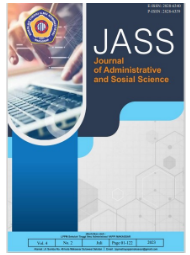Analisis Penerapan Pasal 362 JO Pasal 64 Ayat (1) KUHP dalam Tindak Pidana Pencurian Emas
Studi terhadap Putusan Pengadilan Negeri Nomor 170/Pid.B/2023/PN Kpg
DOI:
https://doi.org/10.55606/jass.v6i1.2138Keywords:
Substantive Justice, Forgery of Letters, Judge's Consideration, Continued Acts, TheftAbstract
This study examines the application of Article 362 jo Article 64 paragraph (1) of the Criminal Code (KUHP) in the Kupang District Court Decision Number 170/Pid.B/2023 against the defendant Sherly Oktaviana Nggeon, who was proven to have committed the crime of repeatedly stealing gold at her workplace, Toko Mas Sahabat. This study aims to assess the accuracy of the application of criminal law norms to concrete facts revealed at the trial and analyze the judge's considerations both from juridical and non-juridical aspects in imposing a verdict. The method used is a normative juridical approach with secondary data sources obtained through literature studies of laws and regulations, doctrines, and court decisions. The results of the study show that although the panel of judges has formally applied Article 362 jo Article 64 paragraph (1) of the Criminal Code by qualifying the defendant's actions as a continuing act (voortgezette handeling), this approach is not entirely appropriate substantively. The act of theft was carried out in different periods, against different objects, and accompanied by the forgery of a memorandum of sale of elements that can legally be qualified as a separate criminal offense based on Article 263 of the Criminal Code. However, in the judge's decision, this act of forgery was not explicitly considered either as an additional charge or as a burden of punishment. This raises the issue of justice, considering that the merging of all acts into one criminal act reduces the weight of criminal responsibility that the defendant should receive, and does not fully reflect the overall dimension of the crime committed. From a non-juridical aspect, the judge considered the defendant's background, good faith to return the damages, and the social and economic conditions of the defendant in imposing a two-year prison sentence. However, this consideration is considered disproportionate when compared to the amount of loss, the consistency of the evil act, and the existence of counterfeiting which contributes to aggravating the character of the crime. This study emphasizes the importance of a more comprehensive legal approach in qualifying compound crimes (concursus realis), as well as the need for judges to
References
Adami Chazawi. (2006). Kejahatan terhadap harta benda. Malang: Bayumedia Publishing.
Ali, Z. (2011). Metode penelitian hukum. Jakarta: Sinar Grafika.
Andika, T., Lapian, M., & Pangemanan, S. (2017). Penerapan prinsip-prinsip good governance dalam pelayanan publik di Kota Manado. Jurnal Eksekutif, 1(1).
Anwar, H. A. K. M. (n.d.). Hukum pidana bagian khusus (KUHP Buku II). Bandung: Citra Aditya Bakti.
Efendi, J., & Gunadi, I. (2014). Hukum pidana. Jakarta: Kencana.
Emzir. (2016). Metodologi penelitian kualitatif: Analisis data. Jakarta: Raja Grafindo Persada.
Gunadi, I., & Efendi, J. (2014). Hukum pidana. Jakarta: Kencana.
Ishaq. (2018). Dasar-dasar ilmu hukum. Jakarta: Sinar Grafika.
Kitab Undang-Undang Hukum Pidana (KUHP).
Moeljatno. (2003). Kitab Undang-Undang Hukum Pidana. Jakarta: Bumi Aksara.
Oksaryan, A. (2021). Analisis yuridis terhadap concursus pada tindak pidana pencurian (Studi Putusan Nomor 202/Pid.Sus/2020/PN Mlg) [Skripsi, Fakultas Hukum, Universitas Sebelas Maret].
Panggabean, H. P. (n.d.). Hukum pembuktian: Teori, praktik, dan yurisprudensi Indonesia. Bandung: Alumni.
Pasal 362 dan Pasal 64 ayat (1) KUHP.
Poernomo, B. (1982). Asas hukum pidana. Yogyakarta: Ghalia Indonesia.
Prasetyo, T. (2018). Hukum pidana (Cet. ke-10). Jakarta: PT Raja Grafindo Persada.
Prodjodikoro, W. (1981). Azas-azas hukum pidana Indonesia. Jakarta: Eresco.
Putusan Nomor 170/Pid.B/2023/PN.Kpg.
R. Susilo. (1991). Kitab Undang-Undang Hukum Pidana (KUHP) serta komentar-komentarnya. Bogor: Politea.
Rahardjo, S. (2008). Bunga rampai permasalahan dalam sistem peradilan pidana. Jakarta: Pusat Pelayanan Keadilan dan Pengabdian Hukum.
Sudarsono. (1992). Kamus hukum. Jakarta: Rineka Cipta.
Sudarto. (1981). Kapita selekta hukum pidana. Bandung: Alumni.
Suharto, R. M. (2002). Hukum pidana materiil: Unsur-unsur obyektif sebagai dasar dakwaan. Jakarta: Sinar Grafika.
Sunggono, B. (2003). Metode penelitian hukum (Cet. ke-5). Jakarta: PT Raja Grafindo Persada.
Suryanto. (2018). Hukum acara pidana. Zifatama Jawara.
Tri Andirsman. (2009). Hukum pidana. Bandar Lampung: Universitas Lampung.
Undang-Undang Nomor 48 Tahun 2009 tentang Kekuasaan Kehakiman (Pasal 5 ayat 1).
Wirjono, P. (1981). Azas-azas hukum pidana Indonesia. Jakarta: Eresco.
Downloads
Published
How to Cite
Issue
Section
License
Copyright (c) 2025 JOURNAL OF ADMINISTRATIVE AND SOCIAL SCIENCE

This work is licensed under a Creative Commons Attribution-ShareAlike 4.0 International License.








